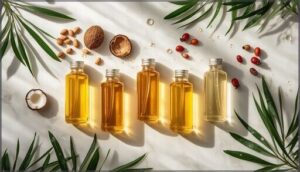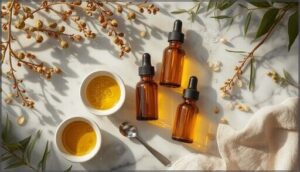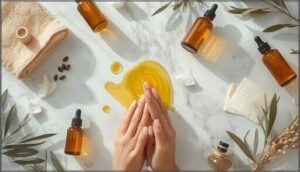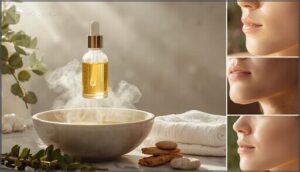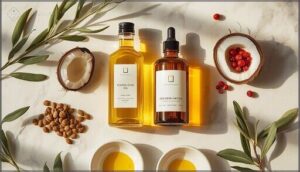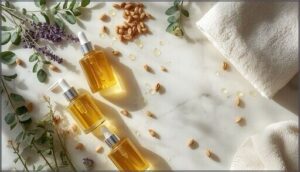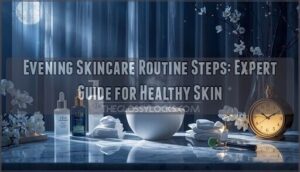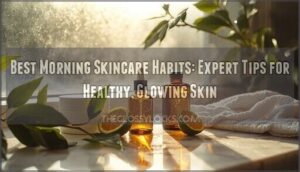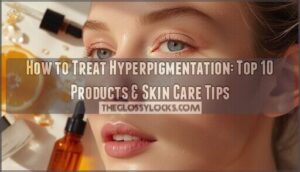This site is supported by our readers. We may earn a commission, at no cost to you, if you purchase through links.

The science is simple: oil attracts oil, which is why even oily and acne-prone skin types often respond better to oil cleansing than harsh, drying alternatives. From lightweight jojoba to nourishing avocado oil, different botanicals offer distinct benefits for various skin concerns.
The right natural cleansing oil can transform your routine from a stripping chore into a nourishing ritual that actually improves your skin’s health over time.
Table Of Contents
- Key Takeaways
- Top 10 Natural Cleansing Oils Reviewed
- 1. TATCHA Camellia Cleansing Oil Makeup Remover
- 2. Anua Heartleaf Cleansing Oil Pore Control
- 3. MARA Algae Cleansing Oil Makeup Remover
- 4. Kiehls Midnight Recovery Cleansing Oil
- 5. Beauty of Joseon Ginseng Cleansing Oil
- 6. IUNIK Calendula Jojoba Cleansing Oil
- 7. Sulwhasoo Gentle Cleansing Oil Makeup Remover
- 8. Peach Lily Ginger Oil Cleanser
- 9. Dermalogica Precleanse Oil Cleanser Makeup Remover
- 10. Biossance Squalane Antioxidant Cleansing Oil
- Key Benefits of Oil Cleansing
- Best Natural Oils for Different Skin Types
- How to Oil Cleanse Effectively
- Comparing Cooking Oils Vs. Unrefined Oils
- Expert Tips for a Healthy Skin Routine
- Frequently Asked Questions (FAQs)
- Conclusion
Key Takeaways
- Oil cleansing works because oil dissolves oil, making it more effective than foam cleansers at removing waterproof makeup and sunscreen while preserving your skin’s natural protective barrier instead of stripping it away.
- Match your cleansing oil to your skin type: jojoba for oily skin (mimics sebum and reduces oil production by 23%), sunflower seed for acne-prone skin (high linoleic acid prevents clogging), and coconut or olive oil for dry skin (boosts hydration up to 149%).
- Always choose cold-pressed, unrefined oils over cooking oils—refined versions lose beneficial nutrients through heat processing and may contain solvent residues or contaminants that can irritate your skin.
- Apply oil to dry skin, massage for 1-2 minutes, then emulsify with warm water using a washcloth before rinsing thoroughly; expect an adjustment period of 2-4 weeks as your skin recalibrates from traditional cleansers.
Top 10 Natural Cleansing Oils Reviewed
Finding the right cleansing oil can transform your skincare routine, but with so many options on the market, it’s hard to know where to start.
We’ve tested and evaluated the top natural cleansing oils available in 2025 based on their ingredients, effectiveness, and suitability for different skin types. Here’s what made our list of the best natural oils for skin cleansing.
1. TATCHA Camellia Cleansing Oil Makeup Remover
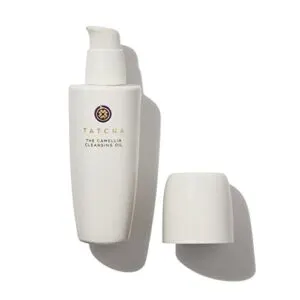
TATCHA’s Camellia Cleansing Oil sits at $50, but there’s real substance behind that price tag. This 2-in-1 makeup remover and cleanser blends Japanese Camellia Oil—rich in oleic acid and antioxidants—with TATCHA’s Hadasei-3 complex, a proprietary blend of fermented Japanese superfoods.
You’ll see strong makeup removal efficacy, even with waterproof formulas, though stubborn mascara occasionally holds its ground. The Camellia Oil benefits shine through with added moisture and nourishment, making it particularly suitable for dry, sensitive, or eczema-prone skin.
Among natural oils and cleansing oils, this one balances luxury with function, justifying its price through quality oil cleanser ingredients.
Best For: Anyone with dry, sensitive, or eczema-prone skin looking for a luxurious cleansing oil that removes makeup while adding moisture—especially if you don’t mind spending $50 for premium ingredients.
- Removes most makeup effectively, including waterproof formulas, while nourishing skin with Japanese Camellia Oil and antioxidants
- Gentle enough for all skin types, particularly beneficial for dry or sensitive skin that needs extra hydration
- Works as both makeup remover and cleanser in one step, plus supports education equality with each purchase
- Expensive at $50, which may be a barrier for budget-conscious buyers
- Can struggle with stubborn waterproof mascara despite handling most makeup well
- Some users find the texture too oily or rich, and the travel size feels overpriced
2. Anua Heartleaf Cleansing Oil Pore Control
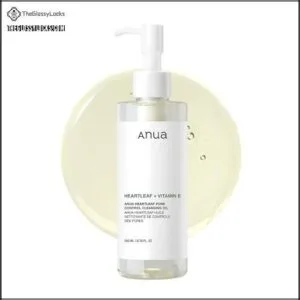
At $17.69, the Anua Heartleaf Cleansing Oil offers serious value. It combines heartleaf extract—known for anti-inflammatory heartleaf benefits—with sunflower, jojoba, olive, and macadamia oils to dissolve makeup and sebum without harsh rubbing.
User reviews highlight noticeable pore reduction (some report clearer blackheads within a week) and a lighter texture that won’t clog pores.
Ingredient analysis shows it’s free from parabens, sulfates, and comedogenic additives, though irritation potential exists for very sensitive skin. Testing showed a 22.81% reduction in sebum after four weeks.
Application tips: Massage onto dry skin for 1-2 minutes, emulsify with warm water, then rinse thoroughly.
Best For: People with oily or acne-prone skin looking for a gentle, non-comedogenic cleansing oil that removes makeup while controlling sebum and reducing pore appearance.
- Effectively dissolves makeup and stubborn mascara without harsh rubbing, thanks to its blend of sunflower, jojoba, and macadamia oils
- Clinical testing showed a 22.81% reduction in sebum after four weeks, plus noticeable pore reduction and blackhead removal reported by users
- Free from parabens, sulfates, and pore-clogging ingredients, making it suitable for sensitive and acne-prone skin types
- May leave skin feeling oily if not followed up with a foam cleanser as part of double cleansing
- Some users reported pump leakage issues and occasional breakouts during the trial period
- Requires 1-2 minutes of massaging to effectively remove sebum and clear sebaceous filaments, which takes more time than quick cleansing
3. MARA Algae Cleansing Oil Makeup Remover
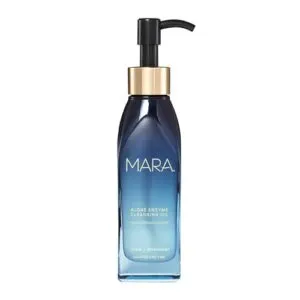
MARA Algae Cleansing Oil ($58) stands out for its marine-powered formula. You’ll find spirulina, kelp, and laminaria digitata delivering antioxidants alongside four fruit enzymes—papaya, pineapple, grapefruit, and pumpkin—for gentle enzyme exfoliation.
Jojoba, sunflower, chia, and moringa seed oils combine with squalane hydration to boost moisture by up to 29% after one use. It removes waterproof makeup without scrubbing, transforming into a milky emulsion that rinses clean.
Consumer reviews consistently rate it 5.0/5, and clinical tests confirm 100% effective makeup removal with no irritation. Suitable for all skin types, including sensitive and acne-prone skin.
Best For: Anyone seeking a luxurious, marine-powered cleansing oil that removes waterproof makeup while hydrating sensitive or acne-prone skin with antioxidant-rich algae and fruit enzymes.
- Removes waterproof makeup and sunscreen in one step without scrubbing, transforming into a milky emulsion that rinses clean with no residue
- Boosts hydration by up to 29% after one use with squalane, chia, and marine algae that strengthen the skin barrier and improve texture
- Packed with antioxidants from spirulina, kelp, and four fruit enzymes that gently exfoliate and protect against environmental damage
- Expensive at $58 for 4 ounces, which may not fit tighter budgets despite lasting 2-3 months with daily use
- Limited bottle size means no travel-friendly or budget-conscious options available
- Some users report not seeing dramatic differences that justify the premium price point
4. Kiehls Midnight Recovery Cleansing Oil
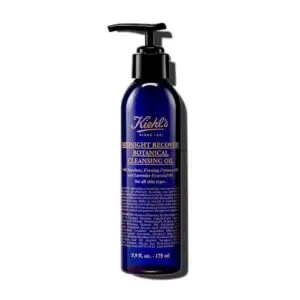
Kiehl’s Midnight Recovery Cleansing Oil ($38) combines botanical ingredients like evening primrose oil, lavender essential oil, and squalane in a lightweight formula. Ophthalmologist-tested and non-comedogenic, it safely dissolves makeup, even around the eyes. The oil transforms into a milky emulsion when massaged with water, removing impurities without leaving residue.
Suitable for dry, sensitive, and maturing skin, users report softer, more hydrated skin after just one use. Application is simple: apply three to four pumps on dry skin, massage for 30 seconds, then rinse. The dark bottle preserves the antioxidant integrity of the formula.
With cleansing oils growing in popularity at 10.4% annually, this $38 option offers solid market performance.
Best For: Anyone with dry, sensitive, or maturing skin who wants a gentle, effective makeup remover that hydrates while cleansing.
- Dissolves all makeup, including waterproof formulas, without irritation or residue—ophthalmologist-tested and safe for eye area
- Leaves skin noticeably softer and more hydrated after one use, thanks to evening primrose oil and squalane
- Non-comedogenic and free from parabens, sulfates, and harsh alcohols, making it suitable for sensitive skin
- At $38, it’s pricier than many drugstore cleansing oils
- Some users may not enjoy the lavender scent
- May require a second cleanser to fully remove all traces of oil, especially around the hairline
5. Beauty of Joseon Ginseng Cleansing Oil
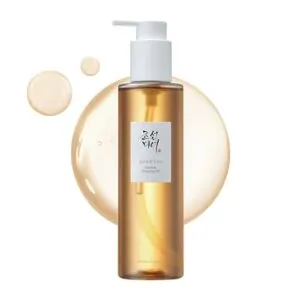
Beauty of Joseon Ginseng Cleansing Oil ($24) features soybean oil at 50% and ginseng seed oil at 0.1%, delivering effective double cleansing with antioxidant protection. The formula includes sunflower seed, moringa seed, and camellia oils that won’t clog pores, making it suitable for all skin types, including acne-prone and sensitive facial skin care needs.
Clinically proven non-irritating through a 24-hour patch test, this cleansing oil dissolves makeup while supporting skin barrier repair through high linoleic acid content. With over 1,040 documented routines and 5-star consumer reviews, you’ll appreciate its lightweight finish and gentle effectiveness.
The ginseng ingredient analysis reveals antioxidants that improve elasticity and protect against environmental stressors.
Best For: Those seeking a gentle, effective cleansing oil that removes makeup and sunscreen while nourishing skin with antioxidant-rich ginseng and plant oils, suitable for all skin types including sensitive and acne-prone.
- Clinically proven non-irritating formula with 50% soybean oil and antioxidant-rich ginseng that dissolves makeup while supporting skin barrier repair
- Clean formulation free of parabens, sulfates, and common allergens, plus it’s cruelty-free and reef safe
- Lightweight, non-greasy finish that rinses clean without clogging pores, backed by over 1,040 documented skincare routines and 5-star reviews
- Strong ginseng scent may be off-putting for those who prefer fragrance-free products
- Requires extended massaging to effectively remove stubborn makeup and deep-seated impurities like blackheads
- At $24 for 255 grams, some users find the price doesn’t justify the extra effort needed compared to other cleansing oils
6. IUNIK Calendula Jojoba Cleansing Oil
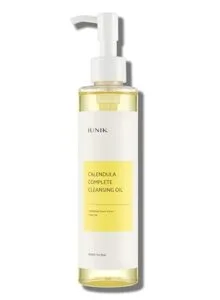
At around $18, IUNIK Calendula Jojoba Cleansing Oil delivers 94% plant-based cleansing with impressive makeup removal power. The formula dissolves waterproof mascara and sunscreen effectively, maintaining hydration levels through its non-comedogenic blend of sunflower and macadamia natural oils.
You’ll find calendula extract calming inflammation while jojoba oil mimics your skin’s natural sebum, making this ideal for sensitive skin without triggering breakouts.
With a 98.9% satisfaction rate, it’s a gentle option that leaves your face soft and clean without stripping essential moisture during skin cleansing routines.
Best For: People with sensitive or acne-prone skin looking for an effective, plant-based cleanser that removes waterproof makeup and sunscreen without stripping moisture.
- Dissolves stubborn makeup and sunscreen while maintaining skin hydration thanks to the 94% plant-based formula with jojoba and calendula oils
- Non-comedogenic and gentle enough for sensitive skin, with a 98.9% satisfaction rate and no reported irritation or breakouts
- Clean formulation free from parabens, sulfates, and synthetic fragrances, plus vegan and cruelty-free certification
- Some users report an unpleasant scent resembling old cooking oil that may be off-putting during use
- Pump dispenser has known leaking issues that can waste product and create mess
- Requires follow-up with a water-based cleanser for complete double-cleansing, adding an extra step to your routine
7. Sulwhasoo Gentle Cleansing Oil Makeup Remover
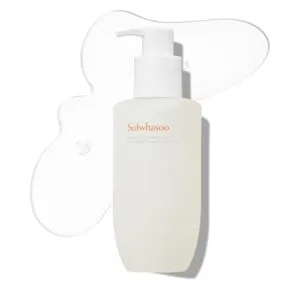
Priced at $40 for 6.4 ounces, Sulwhasoo Gentle Cleansing Oil Makeup Remover blends traditional Korean herbs into a luxurious Herbal Oil Complex featuring camellia, apricot kernel, and sesame oils.
Clinical testing demonstrates impressive makeup removal efficacy—93% of participants confirmed thorough residue elimination, even against waterproof formulas.
You’ll notice remarkable skin comfort results, with 96% reporting a comfortable cleanse and 93% experiencing post-wash moisturization thanks to squalane and the Hydra Capture Complex.
Dermatologically tested for sensitivity and suitable for dry or sensitive skin types, this gentle cleansing oil earns consistent 4+ star market consumer ratings across luxury skincare platforms, though coconut oil content may challenge acne-prone complexions.
Best For: Those with dry or sensitive skin seeking a luxurious, herbal-infused cleansing oil that removes waterproof makeup while leaving skin soft and moisturized.
- Clinically proven makeup removal (93% of users confirmed thorough residue elimination, even for waterproof formulas)
- Exceptionally hydrating and comfortable (96% reported comfortable cleansing, 93% felt moisturized after use)
- Clean formulation free from parabens, sulfates, mineral oil, and other harsh irritants
- Expensive at $40 for 6.4 ounces, which may not last long with regular use
- Contains coconut oil that can clog pores and worsen breakouts for acne-prone skin
- Premium price point may not fit all budgets, especially for a product used daily
8. Peach Lily Ginger Oil Cleanser
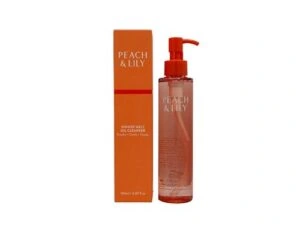
At $39 for 3.4 ounces, Peach & Lily Ginger Melt Oil Cleanser delivers antioxidant-rich cleansing through sunflower seed oil, grapeseed oil, and ginger root extract. The ingredient analysis reveals a gentle, non-comedogenic formula—free from fragrances, parabens, and sulfates—that dissolves waterproof makeup within seconds without leaving a greasy residue.
Consumer satisfaction ratings hit 4.7 out of 5, with users praising its effectiveness in double cleansing routines and compatibility across skin types, including sensitive complexions. Clinical reviews confirm zero reported irritations, making these cleansing oils pregnancy-friendly and eczema-safe.
The unscented blend offers four months of daily use, combining ginger oil benefits with barrier-protective ingredients for refreshed, hydrated skin.
Best For: Anyone seeking a gentle, effective oil cleanser that removes waterproof makeup and sunscreen without irritation, especially those with sensitive skin or pregnancy concerns.
- Dissolves waterproof makeup and sunscreen in seconds without leaving greasy residue or causing eye irritation
- Zero reported allergens or irritations, making it pregnancy-friendly, eczema-safe, and suitable for all skin types including sensitive
- Lasts approximately four months with daily use and features antioxidant-rich ginger and pineapple extracts for brightening benefits
- Ginger oil may trigger breakouts in some acne-prone individuals despite the non-comedogenic formula
- Premium price point at $39 for 3.4 ounces compared to drugstore oil cleansers
- Some users report it doesn’t cleanse thoroughly enough, requiring follow-up with a second cleanser
9. Dermalogica Precleanse Oil Cleanser Makeup Remover
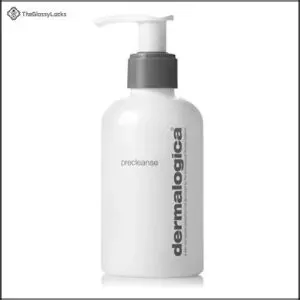
Dermalogica Precleanse Cleansing Oil ($39 for 5.1 ounces) brings double cleansing power through a blend of apricot kernel, olive, rice bran, kukui nut, and borage seed oils—each loaded with essential fatty acids and antioxidants.
Ingredient analysis shows this makeup remover emulsifies instantly, dissolving waterproof mascara and matte lipsticks without clogging pores or leaving residue. Skin compatibility spans all types, including acne-prone and sensitive complexions, though you’ll want to skip it if you have nut allergies.
User reviews back it up: 87% gave it 5/5 stars for effective makeup removal and gentle cleansing that preps your skin for better product absorption.
Best For: Anyone who wears waterproof makeup or heavy sunscreen and wants a gentle, nourishing first-step cleanser that works for all skin types, including oily and sensitive.
- Removes stubborn waterproof makeup and sunscreen without leaving greasy residue, thanks to quick-emulsifying hydrophilic technology
- Packed with nourishing oils like apricot kernel, rice bran, and kukui nut that deliver antioxidants and essential fatty acids to support your skin barrier
- Highly rated by users (87% gave 5/5 stars) and dermatologists for effectiveness without stripping skin or causing tightness
- Not suitable if you have nut allergies due to kukui nut oil in the formula
- Some users report the pump dispenser is tricky to control and can dispense too much product
- Must be followed by a second cleanser to avoid oily residue—it’s a two-step process, not a standalone wash
10. Biossance Squalane Antioxidant Cleansing Oil
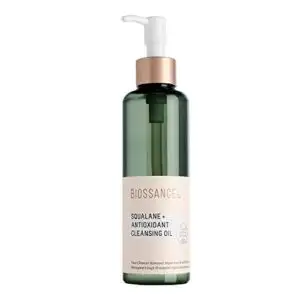
Biossance Squalane Antioxidant Cleansing Oil ($32 for 6.7 ounces) uses sugarcane-derived squalane that mirrors your skin’s natural sebum, making it universally compatible across skin types. This vegan, reef-safe formula dissolves waterproof makeup while delivering antioxidant protection through vitamin E and rosemary extract—shielding against environmental stressors without stripping moisture.
Consumer perception studies show 100% of participants confirmed effective cleansing, while 91% reported easy makeup removal. The lightweight oil emulsifies cleanly, leaving zero greasy residue—ideal for dry, sensitive, and mature skin seeking both cleansing power and barrier protection.
Best For: Anyone with dry or sensitive skin who wants a gentle cleansing oil that removes stubborn makeup while keeping skin hydrated and protected.
- Dissolves waterproof and long-wear makeup effortlessly without harsh rubbing or irritation
- Hydrates while cleansing with sugarcane-derived squalane that mimics your skin’s natural oils
- Packed with antioxidants like vitamin E and rosemary extract to shield skin from pollution and environmental damage
- Unscented formula may not appeal if you prefer fragrant skincare products
- Higher price point at $32 compared to drugstore cleansing oils
- Not specifically designed for acne-prone skin, though some users report improvements
Key Benefits of Oil Cleansing
Oil cleansing might sound counterintuitive, but it’s one of the most effective ways to cleanse your skin without stripping away its natural protection.
The method works with your skin’s biology rather than against it, offering benefits you won’t find in traditional foaming cleansers.
Here’s what oil cleansing can do for you.
Deep Makeup and Sunscreen Removal
When you think about how well modern sunscreens and long-wear makeup stick to your skin, you can see why oil cleansing has become the best approach for actually getting everything off. Natural oils and cleansing oils work on a simple principle: oil dissolving oil.
Oil cleansing works because oil dissolves oil—the most effective way to remove stubborn makeup and sunscreen your skin won’t let go
They break down waterproof makeup and stubborn sunscreen residue that water-based cleansers often leave behind, preventing pore congestion. That’s why double cleansing starts with oil.
Skin Hydration and Barrier Protection
Beyond the cleansing power, natural oils actually help your skin hold onto moisture instead of stripping it away like harsh surfactants can. This oil occlusion creates a protective seal that reduces TEWL reduction (transepidermal water loss) while supporting lipid replenishment.
Natural emollients in these oils work alongside your skin barrier, helping restore ceramide boost and maintain skin hydration without leaving you feeling greasy.
Gentle Cleansing for Sensitive Skin
If your skin reacts to everything from fragrances to foaming cleansers, oil cleansing might be the reset button you didn’t know existed. Hypoallergenic oils like jojoba and sunflower seed deliver gentle cleansing without the harsh surfactants that trigger irritation.
These soothing ingredients support barrier repair while promoting redness reduction, making natural oils ideal for sensitive skin that needs effective cleansing without the inflammatory response.
Maintaining Skin Microbiome Balance
Your skin’s microscopic residents—bacteria, fungi, and other microorganisms—work overtime to defend against invaders, and oil cleansing keeps that ecosystem thriving instead of wiping it out.
Unlike harsh surfactants that strip beneficial bacteria and disrupt pH balance, natural oils preserve microbial diversity essential for skin immunity. This gentler approach to skin cleansing aids skin health by maintaining the protective barrier your skin microbiome creates naturally.
Best Natural Oils for Different Skin Types
Not all oils work for everyone, and matching the right one to your skin type makes a real difference. Your skin’s natural oil production, sensitivity level, and specific concerns all influence which oil will cleanse without causing problems.
Here’s a breakdown of the best natural oils and who they work for.
Coconut Oil for Normal to Dry Skin
Coconut oil works like a moisture magnet for normal to dry skin, improving hydration by nearly 149% after four weeks of consistent use. Clinical trials show it reduces water loss by 37%, reinforcing your skin’s protective barrier function while delivering antimicrobial effects through its high lauric acid content.
It also offers anti-inflammatory benefits that can soothe irritated skin. You’ll find it’s both safe and effective for cleansing, dissolving makeup and sunscreen without clogging pores or triggering irritation in most users.
Olive Oil for Dry and Mature Skin
Olive oil brings centuries of Mediterranean wisdom to modern skincare, delivering vitamins A, D, E, and K directly into parched, aging skin that craves both hydration and antioxidant protection. Its rich emollient properties make it ideal for dry skin cleansing, though you’ll want to remember these application techniques:
- Apply liberally at night to boost skin elasticity
- Use as a makeup remover for gentle, effective cleansing
- Mix with lighter natural oils if you have combination zones
- Massage thoroughly to improve absorption and circulation
The antioxidant properties help combat environmental damage while restoring mature skin hydration.
Sunflower Seed Oil for Acne-Prone Skin
With up to 70% linoleic acid, sunflower seed oil tackles a key deficit in acne-prone skin by thinning sebum and reducing pore congestion. Its non-comedogenic rating of zero, combined with anti-inflammatory action from vitamin E, makes it a standout for natural oil cleansing routines.
Sunflower seed oil is also beneficial because of its anti-inflammatory properties. Choose cold-pressed, high-linoleic varieties and patch-test first.
Remember dietary considerations: eating sunflower seeds may worsen breakouts, even as topical application improves them.
Jojoba Oil for Oily and Combination Skin
Think of jojoba oil as your skin’s smart regulator—it mimics sebum by 25%, reducing excess oil production by 23% after just 28 days.
With a zero comedogenic rating and proven antimicrobial action against acne-causing bacteria, it delivers barrier support without clogging pores.
This wax ester powerhouse offers anti-inflammatory benefits while maintaining skin compatibility across oily and combination skin types, making it ideal for natural cleansing routines.
Avocado and Argan Oil for Nourishment
When dry skin craves deep nourishment, avocado and argan oil step in as nutrient-dense powerhouses, delivering vitamins A, D, E, and essential fatty acids that restore moisture and strengthen your skin’s protective barrier.
Avocado oil penetrates deeply to boost skin elasticity, while argan oil’s antioxidants support repair and hydration. Together, these nourishing oils create natural synergy—enhancing nutrient absorption and leaving your skin supple without heaviness, making them ideal companions in your cleansing routine.
Castor and Grapeseed Oil for Balancing Oils
If combination or oily skin leaves you battling shine by midday, castor and grapeseed oil work as your natural balancing act—drawing out excess sebum without stripping the moisture your skin actually needs.
Castor oil’s astringent properties cleanse deeply, while lightweight grapeseed oil won’t clog pores. Start with a 1:3 ratio of castor to grapeseed in your blend recipes, adjusting based on how your skin responds—less castor if you feel tight after cleansing.
How to Oil Cleanse Effectively
Oil cleansing doesn’t have to be complicated, but getting the technique right makes all the difference. The key is understanding how to select your oils, customize your blend, and apply them properly for your unique skin needs.
Here’s what you need to know to make oil cleansing work for you.
Choosing The Right Base Oil
Your base oil acts as the foundation of your cleansing routine, so selecting one that mirrors your skin’s natural sebum makes all the difference in how well the method works for you. Jojoba oil tops the list for most skin types because its structure closely resembles sebum, making it universally compatible. Sunflower oil offers a lightweight feel with low comedogenic ratings, while avocado oil brings extra nourishment.
When choosing base oils, consider the refining process—cold-pressed, unrefined natural oils preserve more beneficial properties than heavily processed carrier oils.
Customizing Oil Blends for Your Skin
Once you’ve found your ideal base oil, tailoring the blend to match your skin’s unique needs—whether that’s extra hydration, oil control, or both—unlocks the full potential of oil cleansing.
For dry skin, try one part nourishing oil like argan to three parts base oil selection. Oily or combination skin benefits from astringent oil additions like castor or grapeseed.
Adjusting blend ratios based on how your skin responds—tightness means less astringent oil—helps you dial in the perfect formula.
Step-by-Step Oil Cleansing Method
With your custom blend ready to go, applying it correctly makes all the difference between a quick rinse and a true deep clean.
Start with three or four pumps of your natural oils onto dry skin, then massage gently for about a minute using circular motions—this oil cleansing method helps break down makeup and sunscreen.
Wet a warm washcloth and press it against your face to emulsify the oil, then wipe clean. Rinse thoroughly for complete facial cleansing.
Tips for Adjusting to Oil Cleansing
Adjusting to oil cleansing isn’t always instant—your skin might push out a few blemishes in the first week or two as it recalibrates from traditional cleansers. Don’t panic if you see initial breakouts.
Try patch testing new natural oils first, and adjust your oil ratios if your skin feels tight.
Stick with your individual oil blends and warm washcloth routine for at least three weeks—consistency unlocks the real oil cleansing benefits.
Comparing Cooking Oils Vs. Unrefined Oils
Not all oils are created equal, especially for your face. The oils you cook with might seem like a budget-friendly option, but they’re processed differently than those intended for skincare.
Here’s what you need to know about choosing between refined cooking oils and unrefined, cold-pressed options for cleansing.
Safety and Purity Considerations
Not all natural oils are created equal, and the distinction between cooking-grade and cosmetic-grade ingredients matters greatly for your skin’s safety. Cooking oils often contain residual solvents and contaminants from industrial processing that can trigger skin irritation or allergic reactions. Look for products with regulatory compliance certifications like COSMOS or EWG Verified®, which require rigorous allergen testing and sourcing transparency. These standards help minimize oil adulteration and contaminant risks, protecting you from hidden synthetic compounds that plague up to 75% of commercial lavender oils.
| Quality Indicator | What to Look For |
|---|---|
| Certifications | USDA Organic, COSMOS, EWG Verified® |
| Testing Documentation | COAs with GC/MS analysis, pesticide testing |
| Sourcing Details | Batch-level traceability, extraction method disclosure |
Benefits of Cold-Pressed and Unrefined Oils
Cold-pressed and unrefined oils preserve the natural nutrients and antioxidants that heat processing can destroy, making them far more effective for your skin than their refined counterparts. These botanical oils maintain greater nutrient retention and bioavailability, delivering vitamins and fatty acids your skin can actually use. Refining effects strip away beneficial compounds while adding chemicals that compromise purity standards, whereas unrefined cleansing oils work with your skin’s natural biology.
| Processing Method | Impact on Skin Benefits |
|---|---|
| Cold-Pressed | Preserves enzymes, vitamins, and antioxidants |
| Heat-Refined | Destroys heat-sensitive nutrients and phytocompounds |
| Chemical Extraction | Leaves solvent residues that irritate skin |
| Unrefined | Maintains natural color, aroma, and therapeutic properties |
| Environmental Impact | Cold-pressing uses less energy and fewer chemicals |
Potential Allergic Reactions and Skin Safety
While natural oils rarely trigger allergic reactions compared to synthetic ingredients, understanding oil allergy prevalence and risk factor analysis remains crucial. Essential oils account for approximately 5-10% of contact allergic reactions in dermatology clinics, with symptoms ranging from mild skin redness to persistent rashes. Proper oil storage is essential to prevent oxidation, which can increase the risk of adverse events.
| Risk Factor | Impact on Sensitive Skin |
|---|---|
| Atopic History | Increases sensitivity to natural oils considerably |
| Concentrated Use | Elevates allergic reaction risk with repeated exposure |
| Oxidized Oils | Triggers irritant responses and inflammation |
| Citrus Oils + UV | Causes photosensitivity in 3-5% of cases |
Patch testing before widespread use is a valuable tool to identify potential allergens early, helping to mitigate risks associated with natural oils.
Expert Tips for a Healthy Skin Routine
Getting oil cleansing right means knowing when and how to use natural oils throughout your day. The timing of application, pairing with other products, and understanding sun exposure all affect how your skin responds.
Here’s what you need to know to build a routine that works.
Morning Vs. Night Application of Oils
Timing your oil application can make the difference between a healthy glow and a greasy shine—or worse, sun-damaged skin.
In the morning, apply a thin layer of natural oils to your facial skin, allowing proper oil absorption rates before layering sunscreen for compatibility.
At night, your skincare routine can include a more generous application, as nighttime oil benefits include enhanced skin repair timing when your skin regenerates most actively.
Incorporating Oils Into Your Skincare Regimen
Adding oils to your skincare routine doesn’t mean throwing out everything else—it’s about finding where they fit in the lineup you already use. Think oil layering: cleansing oils go first, then serum compatibility matters—apply water-based serums before facial oils.
Adjust oil frequency and targeted treatments with seasonal adjustments; your skin needs more moisture in winter, less in humid months. Let your skin cleansing routine guide what stays.
Using Toners and Moisturizers After Oil Cleansing
After you’ve rinsed away the oil, your skin isn’t quite done yet—toner and moisturizer step in to lock down hydration and balance your freshly cleansed face.
Here’s the right product order for maximum skin hydration:
- Apply toner first to restore pH levels and prep your skin to absorb what comes next
- Wait 30 seconds before layering—toner benefits disappear if you rush the process
- Choose water-based moisturizer types for oily skin; cream formulas work better on dry skin
- Pat, don’t rub—layering techniques matter when working natural oils into your skin care routine
Protecting Skin From Sun Damage When Using Oils
Some oils can make your skin more sensitive to UV rays, so you’ll want to pair your morning routine with sunscreen to keep damage at bay. Apply a thin layer of oil in the morning, then layer SPF 30 or higher before heading outdoors.
Look for antioxidant-rich oils like sunflower seed oil to combat free radicals from sun exposure—they won’t replace sunscreen but add extra protection against skin damage.
Frequently Asked Questions (FAQs)
How long does oil cleansing take to show results?
Like finding the right telegraph operator for your message, oil cleansing requires patience. Initial breakouts may occur as your skin adjusts, but consistency matters—most people see improvements within two to four weeks.
Realistic expectations and choosing quality oils suited to your skin type are essential for skin health.
What are common mistakes when starting oil cleansing?
Choosing the incorrect oil for your skin type, inconsistent routines, and harsh rubbing are common pitfalls. Not emulsifying properly and ignoring reactions like skin blemishes or pore-clogging can also cause issues.
Always consider allergic reactions and adjust your oil cleansing approach accordingly.
Can you use cooking oils from your kitchen?
You might worry that kitchen oils aren’t clean enough, but the truth is they carry risks. Cooking oils are often refined and may contain additives unsuitable for skin.
Unrefined, cold-pressed oils offer better purity and safety for cleansing without irritation.
Do cleansing oils expire or go rancid quickly?
Yes, cleansing oils expire and can go rancid. Shelf life varies by oil type and storage. Antioxidant-rich oils last longer.
Heat, light, and air exposure accelerate rancidity. Store your natural oils in cool, dark places to extend their usability.
Conclusion
Think of your skincare routine like a vinyl record collection—you wouldn’t play them on a cheap player. The best natural oils for skin cleansing deserve the same respect: choose quality, cold-pressed formulas that match your skin’s needs.
Oil cleansing isn’t just another trend; it’s a scientifically sound method that works with your skin’s biology, not against it. Whether you’re drawn to jojoba’s balancing properties or camellia’s antioxidant power, you’re investing in a ritual that actually nourishes while it cleanses.
- https://cna.st/affiliate-link/LXEWYg9a66eEc5nEcnqZY5zRYjXy732Ks2EbJqZVGXjmSj58peUvLAgQhQb4MtmVLrFL9HvCbxbjf3zKhey6tn6krm51gP7dW28rze8GjtZhn8JB3F1BgQ2s1fEaMiM4nDhdEnvER2FxgTif6gw2Mvxbvsk8kVzLn8t2aza2TKmgDxpu3J48a6iYo2NAkDHFnzwPL8WH5a55yF9u5dsujw6x9J3sTE1sDAbQiwQ3zcGNscKFLF2a2gbDCw4ngnCyKW9b5Ne8qsN2MFKyGDysgpVwdQ7KVzZFr99LBi7kTYKuv3km8sRMVQm5og7pxvqXLBv1jdskchwoukysdfCeV48hasZjchheXEP8kvDP9WVQ4xU4Vyf3JTnS4s5kiev61i9ztea8RanWPT5u
- https://pubmed.ncbi.nlm.nih.gov/31321504/
- https://www.mountainroseherbs.com/catalog/ingredients/carrier-oils
- https://www.ulta.com/p/heartleaf-pore-control-cleansing-oil-pimprod2048919?sku=2634188
- https://skinsort.com/products/anua/heartleaf-pore-control-cleansing-oil

